Why do certain four-legged friends from Japan command such global admiration while remaining deeply rooted in their heritage? This guide explores the enduring appeal of these remarkable animals, blending centuries-old traditions with contemporary family life.
Discover breeds shaped by rugged mountain terrains and refined through generations of companionship. From compact hunters to gentle giants, each possesses distinct physical traits and temperaments perfected over time. Learn how their intelligence and loyalty translate into modern household dynamics.
The following sections break down essential care considerations, historical significance, and behavioral patterns. You’ll gain insights into everything from exercise requirements to grooming needs specific to different types. Practical advice helps potential owners match lifestyles with appropriate companions.
Historical records reveal fascinating origins – some varieties nearly disappeared during wartime, only to be revived through dedicated preservation efforts. Modern enthusiasts continue celebrating these animals through cultural festivals and specialized breeding programs.
Whether you’re drawn to spirited smaller companions or majestic larger guardians, this resource provides trustworthy information for making informed decisions. Understand how ancient survival instincts coexist with affectionate family-oriented behaviors in today’s homes.
Introduction to Japanese Dog Breeds
Japan’s canine heritage spans rugged hunters, loyal guardians, and affectionate companions. Six ancient breeds form the Nihon-Ken group, officially recognized for their cultural significance. These differ from later-developed varieties through their preserved lineage and traditional roles. This guide explores both categories, offering insights into their histories, physical traits, and temperaments.
Understanding breed-specific characteristics helps owners provide proper care. Some excel in active households, while others thrive in calm environments. Many retain instincts from centuries of hunting or guarding, requiring thoughtful training approaches.
Distinctive features set these animals apart. The spirited Shiba Inu, noble Akita, and fluffy Japanese Spitz showcase diverse sizes and coats. Each breed’s background influences modern behavior—whether alert independence or gentle companionship.
Upcoming sections detail care requirements, exercise needs, and grooming routines tailored to individual types. By matching lifestyles with breed traits, you’ll discover which companion aligns with your home dynamics. Explore their stories to appreciate how history shapes today’s beloved pets.
The Rich History of Japanese Dogs
Centuries of tradition shape the unique legacy of Japan’s cherished canines. Archaeological evidence reveals their ancestors accompanied humans as early as 10,000 B.C., evolving alongside communities in mountainous and coastal regions. These animals weren’t just companions—they hunted game, guarded homes, and even aided in wartime efforts.
Consider the Shiba Inu, tracing its lineage to 300 B.C. hunters. Their compact size and sharp reflexes made them ideal for flushing birds in dense forests. Similarly, the Akita’s protective instincts stem from guarding nobility during feudal eras. The legendary Hachiko epitomizes this loyalty, waiting nine years for his owner at a Tokyo train station.
Breeding practices preserved these traits through generations. Selective pairings emphasized courage, intelligence, and adaptability—qualities still evident today. Modern versions retain their ancestors’ independence but thrive in family settings with proper socialization.
Cultural reverence elevated certain breeds to national treasure status. Festivals and art celebrated their roles, while samurai valued them as symbols of resilience. This deep respect ensures historical methods influence contemporary care, helping owners appreciate innate behaviors shaped by time.
Understanding this background helps you nurture their natural strengths. Whether managing a Shiba’s curiosity or an Akita’s protective streak, centuries-old DNA informs modern training approaches.
Shiba Inu: The Iconic Small Hunting Breed
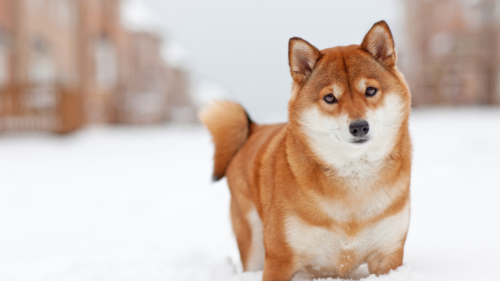
With roots tracing back over two millennia, this compact hunter embodies resilience shaped by Japan’s mountainous wilderness. Originally bred to flush birds and small game, the Shiba Inu combines agility with sharp instincts perfected through generations of survival. Its historical role as a skilled tracker elevated it from practical hunter to cultural symbol, revered for both utility and spirited character.
Origin and Historical Significance
Archaeological evidence places the breed’s ancestors in 300 B.C., thriving in challenging terrains where only adaptable animals survived. Hunters valued their lightning-fast reflexes and silent movement through dense forests. Post-World War II preservation efforts saved the Shiba Inu from near extinction, cementing its status as a national treasure.
Distinctive Appearance and Temperament
The fox-like profile features triangular ears and a plush double coat. Red sesame and black-and-tan variations showcase the signature urajiro pattern—cream markings beneath the jaw and tail. This dog breed balances playful curiosity with fierce independence, often choosing when to engage with family members.
Training requires consistent leadership to channel their intelligence positively. While affectionate with trusted humans, their territorial instincts demand early socialization. Regular mental stimulation paired with brisk walks satisfies their active nature, making them ideal for owners who appreciate spirited companionship.
Akita: The Majestic Guardian of Japanese Dogs
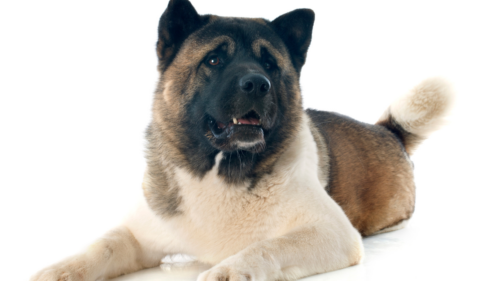
Renowned for their dignified presence and unwavering devotion, Akitas stand as symbols of loyalty in the canine world. The legendary Hachiko, who waited nine years for his owner at a Tokyo train station, epitomizes their profound commitment to family. These powerful companions often weigh over 100 pounds, combining muscular frames with thick double coats suited for harsh climates.
Strong Loyalty and Protective Traits
Akitas form unbreakable bonds with their households while maintaining natural wariness toward strangers. Their protective instincts stem from centuries of guarding nobility and hunting large game. This breed typically shows affectionate behavior with familiar faces but remains alert around unfamiliar people or animals.
Physical strength complements their vigilant nature. Broad shoulders and a deep chest give them an imposing stance, with males often reaching 130 pounds. Early socialization helps channel their courage into positive interactions rather than territorial behavior.
Training and Socialization Tips
Consistent leadership proves vital for managing this intelligent yet strong-willed breed. Start obedience training before six months old using reward-based methods. Exposure to various environments reduces reactivity to stimuli like squirrels or unfamiliar dogs.
Daily exercise needs include brisk walks and puzzle toys to prevent boredom. Mental challenges like scent work or agility courses satisfy their problem-solving instincts. Structured routines help Akitas thrive as calm, confident protectors in modern homes.
Japanese Spitz: A Cheerful and Friendly Companion

Imagine a cloud-like bundle of energy greeting you with bright eyes and a wagging tail. This breed’s joyful demeanor shines through every interaction, blending lively antics with loyal affection. Families find their playful nature irresistible, while singles appreciate their adaptable companionship in various living spaces.
Fluffy Appearance and Exuberant Personality
The Japanese Spitz’s snow-white double coat resembles a plush teddy bear. Its thick fur repels dirt naturally but demands weekly brushing to prevent mats. Seasonal shedding requires daily grooming sessions to manage loose hairs effectively.
Behind that adorable face lies a sharp mind eager to learn. These clever companions master tricks quickly using positive reinforcement. Their love for games like fetch or hide-and-seek keeps households entertained for hours.
Activity and Grooming Requirements
Thirty to sixty minutes of daily exercise maintains their physical and mental health. Combine brisk walks with puzzle toys to satisfy their curiosity. Without stimulation, they might invent their own (often mischievous) entertainment.
Regular vet check-ups help prevent common issues like patellar luxation. Dental care proves crucial—introduce tooth brushing early to avoid problems. Their hypoallergenic coat simplifies maintenance between professional grooming appointments.
This breed thrives when included in family activities. Whether accompanying you on errands or cuddling during movie nights, their cheerful presence enhances modern lifestyles. Their adaptability makes them ideal for both apartments and houses with yards.
Shikoku: Agile and Enduring Japanese Heritage
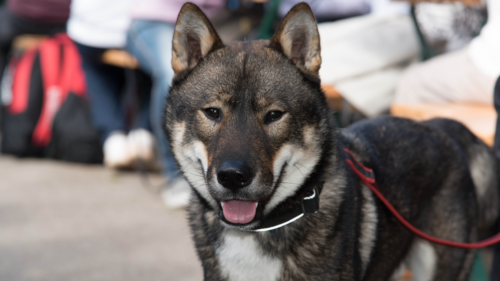
Agility meets endurance in this medium-sized marvel, a breed forged by rugged mountain terrain. Originally tracking wild boar through dense forests, the Shikoku combines ancient survival skills with modern adaptability. Its compact frame hides surprising strength—a muscular build perfected over centuries of challenging hunts.
Hunting Roots Meet Modern Homes
Historical records show these canines pursued deer and boar across Shikoku Island’s steep slopes. Their double coat repelled harsh weather, while keen senses detected prey miles away. Today’s versions retain that athleticism, requiring 90+ minutes of daily exercise through hiking or interactive games.
Loyalty runs deep despite their independent streak. Early socialization helps manage strong chasing instincts around smaller pets. Trainers recommend puzzle feeders and scent work to channel natural abilities positively. Structured routines prevent boredom-related mischief in home environments.
Modern adaptations make them suitable for active families. Backyard agility courses or weekend backpacking trips satisfy their need for adventure. Expert tips include secure fencing and leash training—essential for managing sudden bursts of speed during walks.
Traditional breeding emphasized resilience, creating companions who thrive with purpose. Whether mastering obstacle courses or patrolling suburban yards, their heritage shines through every calculated movement and alert stance.
Tosa: Unpacking the Giant Japanese Mastiff
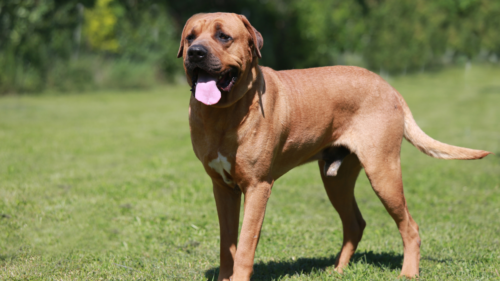
Standing as one of the most imposing canine breeds, the Tosa commands attention through sheer physical presence. Developed in the 19th century, this mastiff-type dog breed originated from selective breeding programs focused on creating unmatched combat prowess. Modern enthusiasts appreciate its evolution into a loyal companion—though handling requires specialized knowledge due to its historical background.
Fighting Legacy and Powerful Build
Weighing up to 200 pounds, the Tosa’s muscular frame reflects its past as a fighting dog. Breeders combined European mastiffs with local hunting dogs to enhance size and tenacity. The short, dense coat requires minimal grooming but provides protection during physical activity.
Modern Temperament and Handling
While no longer bred for combat, the Tosa retains a reserved demeanor around strangers. Early socialization helps manage its protective instincts. Experienced owners should establish firm leadership through reward-based training to channel its intelligence positively.
This breed thrives with consistent routines and spacious environments. Daily walks and mental challenges prevent boredom-related behaviors. Prospective adopters must prioritize secure fencing and leash discipline to safely manage its 150-200 pound strength during outdoor activities.
Hokkaido: The Resilient Mountain Search and Rescue Dog
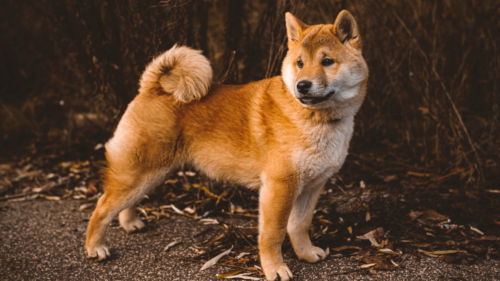
Bounding through snowdrifts with unwavering focus, this breed exemplifies endurance forged by Japan’s northern wilderness. Originally bred by the Ainu people for hunting bears and rescuing stranded travelers, the Hokkaido thrives in extreme conditions. Its dense double coat and muscular build reflect centuries of adaptation to icy terrains.
Adaptability in Cold Climates
Built for subzero temperatures, the Hokkaido’s waterproof outer coat and insulating underlayer repel snow effortlessly. Thick paw pads provide traction on slippery surfaces, while almond-shaped eyes reduce glare from icy landscapes. These features enabled historical search missions across Hokkaido Island’s treacherous peaks.
Grooming and Exercise Considerations
Weekly brushing manages moderate shedding, increasing to daily sessions during seasonal coat blows. Active households should provide 90+ minutes of exercise daily—hiking or scent games channel their natural tracking instincts. At 44-66 pounds, they require space for vigorous play but adapt well to cold-weather climates.
Their loyal temperament shines through patient training, though stubborn streaks demand consistent leadership. With a life expectancy of 12-15 years, these resilient companions thrive when given purposeful tasks echoing their rescue heritage. Expert breeders recommend puzzle toys to satisfy their problem-solving drive while reinforcing obedience.
Kai Ken: The Elusive “Tiger Dog” with Wild Stripes
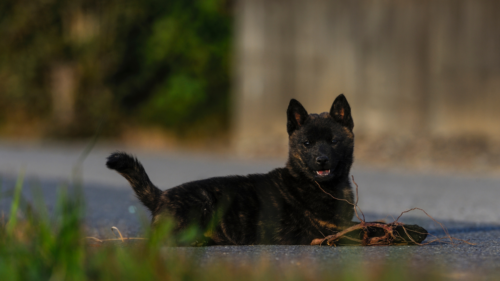
Rare even in its homeland, the Kai Ken’s brindle coat ripples like sunlight through bamboo forests. This medium-sized marvel combines wild aesthetics with sharp intelligence, earning its “tiger dog” nickname through distinctive striped patterns. As one of Japan’s six native breeds, it remains relatively unknown outside specialist circles despite its striking appearance.
Rare Breed Characteristics
Muscular and agile, the Kai Ken thrives in active households. Its dense double coat showcases unique brindle variations—black, red, or brown stripes that provide natural camouflage. Originally bred to track boar and deer in mountainous regions, this breed retains strong hunting instincts alongside loyal watchdog tendencies.
High energy levels demand 90+ minutes of daily exercise. Hiking, agility courses, or scent games channel their natural drive effectively. Training requires patience due to their independent problem-solving style, though positive reinforcement yields excellent results. Early socialization helps balance their alert nature with family-friendly behavior.
Owners often note the Kai Ken’s preference for bonding closely with one person. Their adaptability shines in homes with consistent routines and access to outdoor spaces. While rare, this breed appeals to experienced enthusiasts seeking a distinctive companion with untamed beauty and unwavering focus.
Kishu Ken: From Powerful Hunters to Loyal Pets
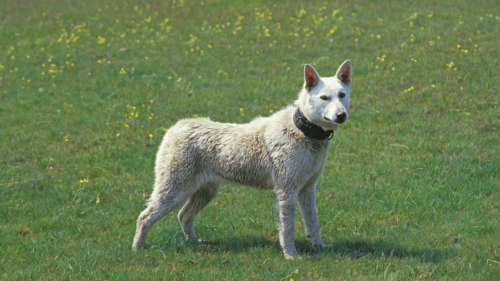
Few breeds embody the spirit of wilderness preservation like the Kishu Ken. Originating in mountainous regions of Mie and Wakayama Prefectures, this medium-sized hunter once tracked wild boar and deer through dense forests. Modern versions retain their ancestors’ athletic build and sharp instincts, now channeled into loyal companionship.
Bravery and Hunting Prowess
Weighing 30-60 pounds, the Kishu Ken’s muscular frame reflects centuries of pursuing challenging game. Its signature white coat—historically practical for visibility during hunts—now symbolizes breed identity. Hunters relied on their courage to confront bears, a trait requiring structured training in domestic settings.
Daily exercise remains crucial for this energetic dog breed. Owners should provide 60+ minutes of hiking or agility drills to satisfy their natural drive. Structured play sessions with puzzle toys mimic hunting scenarios, reducing restlessness while reinforcing obedience.
Early socialization helps transition these strong-willed companions into family life. Reward-based methods work best, balancing their independence with household rules. Though rare outside Japan, dedicated enthusiasts value their unwavering focus and adaptability to modern homes.
Japanese Chin: The Elegant Lapdog with Noble Origins
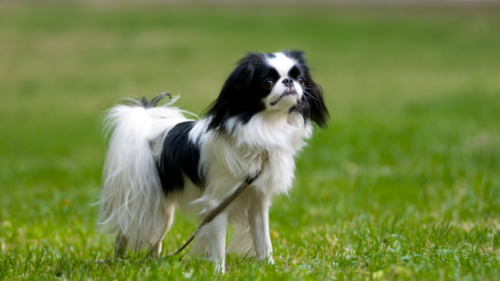
Stepping into royal courts with silent grace, this small companion charmed emperors long before becoming a modern household favorite. The Japanese Chin’s lineage traces to Asian nobility, where they served as treasured gifts between rulers. Their evolution from palace adornment to beloved pet highlights adaptability wrapped in silky fur.
Distinctive Looks and Gentle Nature
Broad, expressive eyes frame a flat face reminiscent of cherished porcelain figurines. The silky coat flows in striking color combinations—black-and-white patterns dominate, though red or tan accents add variety. Weighing under 11 pounds, their compact size suits apartment living while retaining regal poise.
Unlike energetic Pomeranians, Chins prefer calm interactions. They exhibit cat-like behaviors, often perching on furniture or cleaning their face with delicate paws. Early socialization nurtures their affectionate side, though they may remain reserved with strangers.
Care and Exercise Needs
Brushing twice weekly prevents tangles in their luxurious fur. Focus on areas behind ears and leg feathers where mats form easily. Bathe monthly using mild shampoos to preserve natural oils.
Daily needs include short walks and indoor play sessions. Puzzle toys challenge their sharp minds without overexertion. Owners should monitor breathing in heat due to their flat facial structure.
This breed thrives in quiet homes where gentle companionship outweighs rigorous activity. Their low-maintenance exercise routine pairs with meticulous grooming—a fair trade for unwavering loyalty and timeless elegance.
Japanese Terrier: A Small Gem with Big Personality
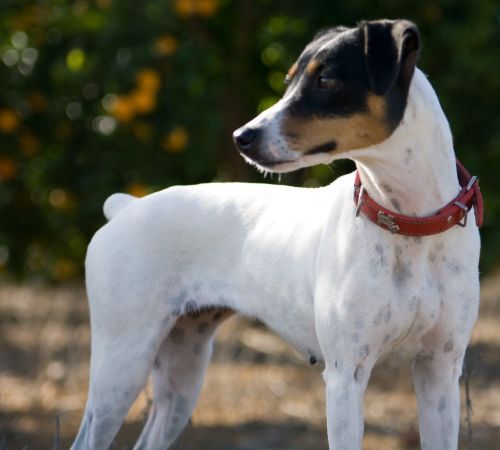
Once teetering on the edge of extinction, a lively companion now charms homes with its bold character. This compact breed stands 11 to 14 inches tall, combining sleek muscles with an expressive face framed by large, attentive ears. Its journey from pre-war popularity to postwar rarity makes every modern encounter a testament to dedicated preservation efforts.
Alertness and Independent Spirit
Bred initially for urban companionship, the Japanese Terrier thrives in dynamic environments. Its sharp intelligence shines through problem-solving skills, though training requires patience. Owners often describe a mix of playful affection and stubborn resolve—traits demanding consistent leadership to channel energy positively.
Daily mental stimulation proves crucial. Interactive puzzle toys and short agility drills satisfy their need for challenges. Unlike some small breeds, this dog prefers varied routines over repetitive tasks, excelling in homes that embrace spontaneity.
Socialization shapes their interactions significantly. Early exposure to diverse people and pets curbs territorial tendencies while nurturing their naturally curious nature. Though reserved with strangers initially, trust-building reveals a loyal companion eager to participate in family adventures.
Prospective owners should anticipate moderate exercise needs—30-minute walks paired with fetch sessions work well. Their short coat needs minimal grooming, but regular nail trims prevent discomfort during active play. For those seeking a spirited partner with historical significance, this breed delivers endless surprises in a petite package.
Understanding japanese dogs: Their Historical Roots and Contemporary Appeal
Breed characteristics rooted in centuries-old roles continue to influence contemporary pet behaviors. Many modern companions retain instincts developed through generations of specialized work, from tracking prey to guarding homesteads. Their energy levels and problem-solving skills often mirror ancestral demands, requiring thoughtful engagement in today’s homes.
The Shiba Inu’s agile movements and alertness stem from mountain hunting traditions, now channeled into interactive play. Similarly, the Shikoku’s endurance translates well to hiking adventures with active families. These adaptations showcase how historical traits evolve to suit urban lifestyles without losing core identity.
Owners benefit from recognizing these connections. A breed’s need for mental stimulation or structured routines often ties directly to its original purpose. Training methods that honor natural instincts—like scent games for former hunters—strengthen bonds while meeting modern needs.
Cultural preservation efforts ensure traditional standards inform responsible breeding practices. This balance maintains distinctive physical features and temperaments people cherish. By appreciating a companion’s heritage, households create environments where historical strengths flourish alongside contemporary comforts.
Caring for Japanese Dog Breeds: Essential Health and Grooming Tips
Proper care for these companions balances ancestral needs with modern routines. Tailored nutrition and consistent grooming ensure their well-being while honoring breed-specific traits. Owners benefit from understanding how to adapt practices for different life stages and climates.
Nutrition and Daily Exercise
High-quality diets rich in protein support active lifestyles. An adult companion might need 400+ calories daily, adjusted for age and activity level. Measure portions to avoid overfeeding—consult your vet for breed-specific guidelines.
Daily exercise prevents boredom and weight issues. Aim for 30-60 minutes of walks or playtime. Puzzle toys engage sharp minds during indoor sessions. Busy families can split activities into morning and evening routines for consistency.
Seasonal Grooming and Coat Maintenance
Thick coats demand weekly brushing, increasing to daily sessions during shedding seasons. Use undercoat rakes and slicker brushes to remove loose fur without damaging the top layer. Avoid shaving—their double layers regulate temperature naturally.
Schedule baths every 2-4 months using gentle shampoos. Trim nails monthly and clean ears weekly to prevent infections. Pair grooming with positive reinforcement to build trust. Annual vet visits catch issues early, ensuring a long, healthy life.
Matching the Right Japanese Dog Breed to Your Lifestyle
Finding a four-legged companion starts with understanding how their natural traits align with your daily rhythm. Active households might thrive with energetic partners like the Shikoku, while calmer homes could prefer the Japanese Chin’s serene companionship. Consider these three pillars: available space, activity preferences, and household dynamics.
Space and Energy Alignment
Compact apartments suit smaller breeds needing moderate exercise, like the Japanese Terrier. These spirited companions adapt well to urban living with short walks and puzzle games. Larger breeds such as the Akita demand spacious yards and experienced handlers to manage their protective instincts.
Busy professionals should evaluate time commitments. High-energy types like the Shiba Inu require 60+ minutes of daily engagement. Retirees or remote workers often succeed with affectionate companions like the Japanese Spitz who enjoy frequent interaction.
Temperament and Family Life
Families with children benefit from patient breeds like the Tosa, known for gentle giant tendencies when properly socialized. Singles might prefer independent thinkers like the Kai Ken, whose loyalty focuses on one person. Always research historical traits—hunting breeds retain strong chase instincts needing structured outlets.
By matching your routine to a breed’s inherent needs, you create harmony. Urban dwellers with limited space? Consider low-maintenance options. Outdoor enthusiasts? Explore agile partners like the Hokkaido. Thoughtful selection ensures both human and canine happiness flourish.
Celebrating the Legacy of Japanese Canine Heritage
The bond between humans and their four-legged companions spans centuries, blending ancient traditions with modern devotion. From spirited hunters to gentle guardians, these breeds carry stories of resilience in every wag and watchful gaze. Their distinct personalities shine through—whether a Shiba’s playful independence or an Akita’s steadfast loyalty.
Vibrant coat colors and patterns reflect generations of careful breeding. Fiery reds, snowy whites, and striking brindles mirror the landscapes that shaped them. Practical care tips shared throughout this guide help owners honor their needs while nurturing timeless traits.
Beyond companionship, these animals teach patience and adaptability. Their enduring legacy appears in cultural landmarks and heartfelt stories like Hachiko’s legendary loyalty. For those inspired to learn more, trusted sites offer detailed breed profiles and preservation initiatives.
Choosing such a companion means embracing living history. Their quiet dignity and joyful presence remind us that the best friendships often transcend words—and centuries.
FAQ
Are Shiba Inus good for first-time pet owners?
Shiba Inus are intelligent but independent, requiring consistent training. Their strong-willed nature may challenge inexperienced owners, though they thrive with patience and structured routines.
How much exercise does a Kishu Ken need daily?
Kishu Kens need 60–90 minutes of vigorous activity daily. Their hunting heritage demands mental stimulation, like puzzle toys, alongside walks or hikes to prevent boredom.
Is the Tosa suitable for apartment living?
Despite their calm demeanor, Tosas need ample space due to their large size. They’re better suited to homes with yards and owners experienced with powerful breeds.
Do Japanese Chins get along with children?
Japanese Chins are gentle but delicate, making them better companions for older kids. Supervised interactions prevent accidental injuries due to their small, fragile build.

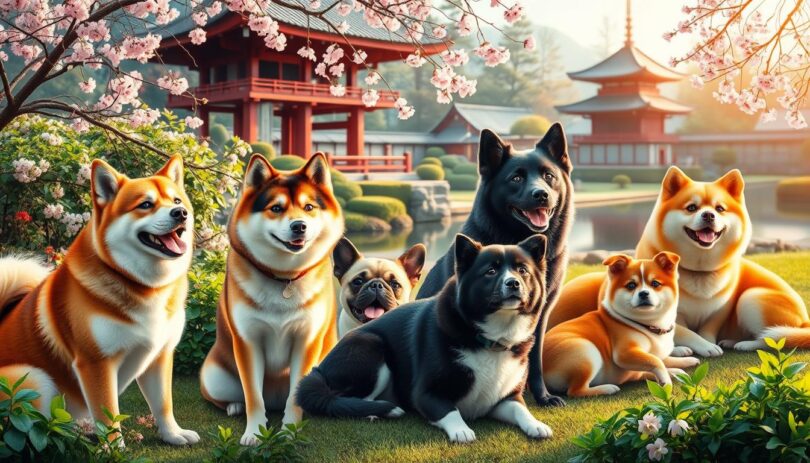

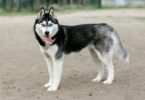






Leave a Comment